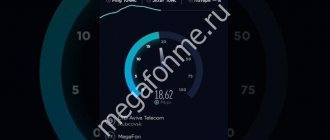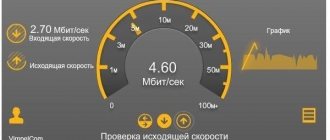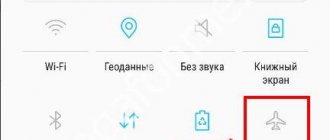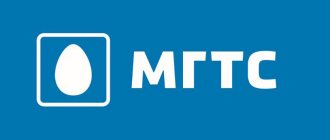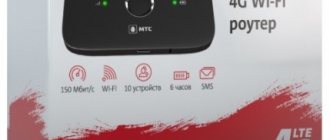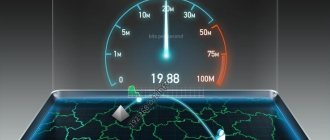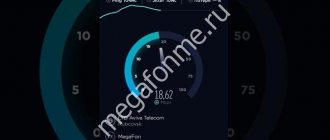Modern wireless Internet is developing very rapidly. Just 3 years ago, no one thought about the massive distribution of 4G throughout almost all of central Russia, and large operators only had it in their plans. Now high-speed Internet is appearing in new settlements. If previous generations 2G and 3G were established standards for a long time, then 4G and LTE are progressing every year. In this article you will learn what the maximum speed of 4G Internet is and how to measure it. Also read in the next section useful material about which is better: 4G or LTE and how they differ from each other.
What speed should 4 G have?
If we take into account the 4G LTE network, which is the first generation of the new 4G technology, the figures will be much lower than stated. Back in 2008, standards were established according to which the maximum speed in 4G networks should have been as follows:
- 100Mb/s for mobile subscribers. These include cars, trains, and so on;
- 1Gb/s for static subscribers (pedestrians and stationary computers).
However, in reality things are worse than by stated standards. These parameters were set by the creators of the technology in ideal conditions without interference, network load and other unpleasant moments. In fact, for static subscribers the real figure does not exceed 100Mb/s. However, operators loudly proclaim 200-300Mb/s. The closest to this figure are Megafon and Beeline, which launched a network with support for LTE Advanced or 4G+. The performance of this standard reaches up to 150Mb/s under ideal conditions. However, Megafon's 4G coverage area makes it clear: the mass distribution of LTE Advanced will have to wait a long time. In addition, the growing number of subscribers will increase the load on the network, which will lead to a decrease in the average.
By the way, a new generation of communication technology is approaching - 5G, its speed is even higher!
Speed
The technology is based on the packet principle of information transfer. This makes it possible to obtain such impressive declared application speeds as 1 Gbit/sec. But such a high real speed of the 4G standard is difficult to achieve, and not a single global network can boast of such a result.
Base stations, or simply towers, of various operators are capable of transmitting data over a distance of 100 km. But this requires a perfectly flat area without various obstacles: hills, ravines, forests, etc.
Special protocols of the International Telecommunication Union have established Internet speed as a standard, which must be at least 100 Mbit/s for objects in motion. As for fixed terrestrial access points, that is, modems or static phones, the transmission speed should be up to 1 Gbit/s. However, today the actual numbers are much lower.
Note! The speed very much depends on the distance to the base station and the presence of obstacles.
The maximum efforts of developers today are directed towards the use of orthogonal frequency division multiplexing (OFDM) technology. For users who have access to data transmission using a modem, a good way to enhance the quality and speed of transmitted and received traffic is MIMO technology. This means that the antennas for receiving and transmitting information are located so that the greatest correlation is obtained in nearby devices.
Regarding the differences between 4G and the third generation standard, its support is fully functional using the packet method. This gives greater speed and throughput. 3G can boast only partial packet transmission, while the largest part is still taken up by channel transmission. Voice messages are sent and received using Voice over LTE.
Important! In Russian cities, 4G speed is quite good, but the same cannot be said about suburbs and remote areas.
How to check 4g internet speed?
You can independently determine what data transfer rates are currently on your phone. To do this, you will need the Speedtest mobile application, which can be downloaded from the Play Market and AppStore. The 4G speed test is launched by pressing just one button when starting the program. The utility will automatically measure the ping to the nearest server with which it will exchange a test data packet. After that, it will measure reception and return and display it on the screen of your device. The same operation can be done from a computer on the website of the same name. Also read on our website about LTE FDD and TDD in Russia and their distribution.
What factors affect speed?
It is noteworthy that, after carrying out one test and after a while another, without moving the phone, you can notice that the speed is constantly changing. This is due to various factors, the appearance or disappearance of frequency interference, the movement of large objects and other reasons.
How to determine normal Internet speed
However, there is a certain set of factors that affect the operation of the mobile network:
- distance of the user's device to the operator's base station. For some networks, operators further limit coverage areas. In this case, the phone, modem or tablet will show that they are within the 4G network, but the speed will not be high;
- If the subscriber is in the city, then the absence of interference is of great importance. The fewer there are, the better the quality of Internet use will be. In addition, the main problem is the presence of signals reflected several times from different surfaces;
- directly affects the number of users simultaneously connected to the relay antenna. There is also an indirect factor - the time period of application. At night, the speed is consistently higher, because most subscribers simply do not use the Internet;
- technical characteristics of a smartphone, tablet or modem. Even among one manufacturer, the use of fourth generation networks for data exchange is radically different for flagship models and budget lines.
The development of mobile communications does not stand still, so providers are developing standards and technologies.
Note! Equipment and software are constantly being improved to provide subscribers with the most stable and high-quality connection with high throughput.
Scalability of frequency channel width in LTE
The most important feature of LTE networks is the scalability of the frequency spectrum they occupy from 1.4 to 20 MHz (possible bands are 1.4, 3, 5, 10, 15 and 20 MHz), which facilitates the rapid implementation of the technology in conditions of limited radio resources. Obviously, the wider the strip, the higher the speeds will be. Table 1 below shows the relationship between bandwidth and the number of subcarriers and resource blocks (a resource block is 12 subcarriers in the frequency domain and one time slot or 7 OFDM symbols in the time domain).
Table 1. Relationship between bandwidth and number of resource blocks
| Band, MHz | 1.4 | 3 | 5 | 10 | 15 | 20 |
| Number of subcarriers | 72 | 180 | 300 | 600 | 900 | 1200 |
| Number of resource blocks | 6 | 15 | 25 | 50 | 75 | 100 |
Control channels in LTE
The information transmitted on the radio interface is divided into service information, which is broadcast over various control channels, and user data of the PDSCH channel (Physical Downlink Shared Channel).
The LTE air interface supports both frequency and time duplexing of uplink and downlink channels (FDD and TDD), which allows you to deploy networks even in the absence of paired bands. Since most operators that have launched LTE have paired frequency bands, in this article we will consider the features of the FDD mode, its frame structure and the relationship between user and service resources.
Rice. 2. LTE frame structure in FDD mode. LTE physical channels
An LTE FDD frame consists of ten 1 ms subframes (NSFR=10). Each subframe consists of two slots, inside of which there can be, depending on the propagation time (cell radius), either 6 or 7 OFDM symbols or resource elements. In Fig. Figure 2 shows a case with a short propagation time (a short cyclic prefix occupying one OFDM symbol) and, accordingly, 7 symbols in a slot.
To synchronize subscribers with the network, special sequences are transmitted in the first subframe of each frame via the primary and secondary synchronization channels (PSS and SSS). They occupy 72 subcarriers (including unused resource elements at the edges of the range) - 72 OFDM symbols. In table 2. a description of the physical control channels is provided, indicating the amount of time-frequency resources spent on them. NRB – number of resource blocks.
Table 2. Purpose of the main control channels and the amount of resources spent on them [1,2]
| Downstream physical channels | Purpose | Amount of time-frequency resources spent, RE/frame (resource element) |
| PSS – Primary Synchronization Channel | Determining the physical cell ID | 72 |
| SSS – Primary Synchronization Channel | Cell ID Group Number Determination | 72 |
| PBCH – Physical Broadcast Channel | This channel transmits information about the occupied bandwidth, frame number, and PHICH configuration | 72*4=288 |
| PDCCH – Physical Downlink Control Channel | The main channel of service information. It transmits most of the system information, data on the distribution of downstream and upstream channel resources between subscribers, etc. | From NSFR* NRB*12 (min)-NPCFICH-NPHICH to NSFR* NRB*12*3 (max)-NPCFICH-NPHICH |
| RS – Reference Signal | Pilot signal. When using MIMO, each antenna transmits its own pilot signals | NSFR* NRB*4* NMIMO |
| PCFICH – Physical Control Format Indicator Channel | Indicates how many OFDM symbols the PDCCH occupies (1 to 3) | 12 |
| PHICH – Physical HARQ Indicator Channel | Transmits HARQ information | 12 |
4G in Russian
As for Russia, it has not remained aloof from 4G. The first company to begin promoting LTE technologies in Russian Land was MegaFon. In addition to MegaFon, two more mobile giants provide access to the fourth generation of mobile Internet - MTS and Beeline. MegaFon currently has the largest 4G network; they managed to install LTE in 38 regions of Russia. While the closest competitors have not even reached the first round number of 4G entities: MTS has 9 connected regions, Beeline has 8.
A little bit of science fiction at last. The Japanese from DoCoMo predict the launch of fifth generation networks (5G) by 2021. The next generation, compared to LTE technology, will have a hundredfold superiority in speed and a thousandfold in throughput. What Internet speed will be available in 5-10 years? Will there be major changes to the mobile infrastructure? Time will tell. Perhaps the now seemingly fantastic 1 Gigabit/second will become a common standard. In the meantime, domestic subscribers can stop drifting in the www-ocean and start surfing its expanses on the “4th cruiser”.
Which USB modem is better? Selecting a 4G modem in the “whistle” format
Classic USB modems in the “flash drive” (“whistle”) form factor are universal devices that are suitable for use both in urban environments and outside the city. Such modems are recommended when the operator's cellular network is limited to the LTE Cat category. 4 (speed up to 150 Mbit/s for receiving and 50 Mbit/s for sending) or the user does not require ultra-fast mobile Internet.
Below is a comparison table of the best 4G modems for computers, laptops and WiFi routers in 2021.
| ZTE MF833T (836F) | Huawei E3372h-320 | ZTE MF825 (830FT) | Huawei E3372M (E3372h-153) | |
| Support for any operators | + | + | + | + |
| Supports popular LTE Band 3, Band 7 and Band 20 standards (1800, 2600 and 800 MHz) | + | + | + | + |
| Support for LTE Band 38 standard (2600 MHz TDD) (MTS Moscow) | − | + | − | − |
| Classic form factor with USB connector | + | + | + | + |
| Availability of connectors for connecting an external antenna | − | + CRC9 | + TS9 | + CRC9 |
| Compatible with WiFi routers | many routers | many routers | many routers | the widest support |
| Support for cheap mobile plans | − | − | − | + |
| Low price | + | + | + | − |
Choosing the best USB modem with WiFi
A modem with WiFi function can be used both as a classic modem and as a WiFi router (via a USB power adapter). This increases the mobility and versatility of the device and allows it to be used in a wide variety of scenarios - in apartments, country houses, offices, etc.
| Huawei E8372h-320 | ZTE MF79u | Huawei E8278 | Huawei E8372M (E8372h-153) | |
| Support for any operators | + | + | + | + |
| Supports popular LTE Band 3, Band 7 and Band 20 standards (1800, 2600 and 800 MHz) | + | + | + | + |
| Support for LTE Band 38 standard (2600 MHz TDD) (MTS Moscow) | − | − | + | − |
| Classic form factor with USB connector | + | + | + folding case | + |
| Built-in WiFi hotspot for 10 devices | + | + | + | + |
| Availability of connectors for connecting an external antenna | − | + TS9 | + TS9 | + TS9 |
| Support for cheap mobile plans | − | − | − | + |
| Low price | + | + | − | − |
Which 4G modem to choose? Our recommendations
When choosing a 4G modem for the Internet, you first need to focus on your needs.
- 4 A G-modem for the Internet in the country should support any operators and have connectors for connecting an outdoor antenna - in case the built-in antennas of the device cannot cope with their task. Support for mobile tariffs will be a nice bonus and will help you save on the Internet. Recommended solution: Huawei E3372h-320 (for regular plans) or Huawei E3372M (for mobile plans). Need WiFi? Pay attention to the Huawei E8372M model!
- 4 A G-modem for a laptop must have a compact body and support modern cellular networks. If your laptop is equipped with a miniPCIe slot for installing a modem, we recommend the uectel EP06-E model as a universal and already proven solution. If your choice is limited to USB modems, you can use the Huawei E3372h-320 or similar.
- 4 G-modem for office should be selected based on the main use case. For a work computer, you can choose an inexpensive USB modem or a combination of a miniPCIe modem and an adapter. However, if not only you, but also your colleagues need Internet in the office, a modem with WiFi will be the best solution!
- 4 A G-modem for a router must meet the main requirement - compatibility! Be sure to check which modems are supported by your WiFi router and choose from the list offered by the manufacturer!
In our online store you can always choose the best 4G modem for specific tasks! To get advice from our specialists, call 8-800-3333-965 or contact the manager in the online chat window!
MIMO to LTE
An important factor when assessing the capabilities of LTE is the use of MIMO (Multiple Input Multiple Output) technology. There are several options for using MIMO - to increase subscriber capacity, while different information is transmitted from different antennas, and to improve coverage. In the latter case, the same information is transmitted from several antennas, which allows the subscriber device to combine the signal from different antennas, improving its quality. Usually,
To increase subscriber capacity, operators use the first MIMO option. In this case, using MIMO 2x2 (NMIMO=2 - MIMO order) will double the downlink data rate. However, the implementation of such a scheme will require additional time-frequency resources for transmitting antenna reference pilot signals.[1]
New prospects for the mobile market
The emergence and development of domestic 4G was due to constantly growing demand. In 2012 alone, the number of mobile Internet users in the world was more than one billion people. During the year, traffic consumption indicators more than doubled. According to the most preliminary forecasts, by 2021 this figure will increase another 10 times. The availability of smartphones and relatively low prices for mobile Internet have significantly increased data transfer volumes and the load on mobile networks. 4G is designed to solve this problem in Russia: it will take away users with maximum Internet activity, thereby unloading 3G communication channels for moderate “traffic eaters”. It is expected that just as 3G once influenced the emergence of mobile markets, cloud technologies and other services, LTE networks will have a serious impact on the mobile market.
This is a huge opportunity for providers to promote new services to the masses. The 3G era was characterized by simple applications, music content and casual games, with minimal requirements. The 4G generation, with its data transmission potential, in turn, can seriously develop the video component of the mobile world. We are talking not only about videos on Youtube and downloading films from video hosting sites, but about full-fledged mobile television, focused entirely on client requests. Of course, the increase in maximum speed will certainly affect the gaming segment: the time is not far when the battles of “skill” games with modern graphics will be transferred from laptops and PCs to portable media.
